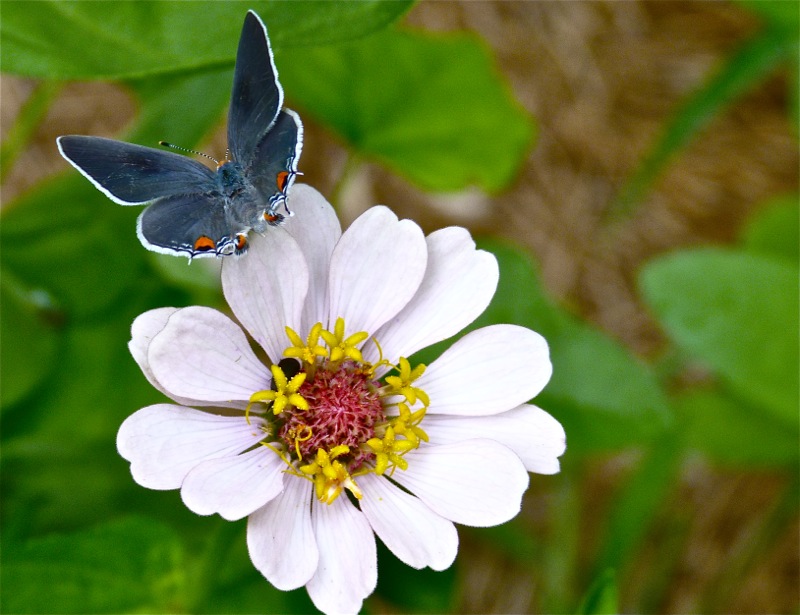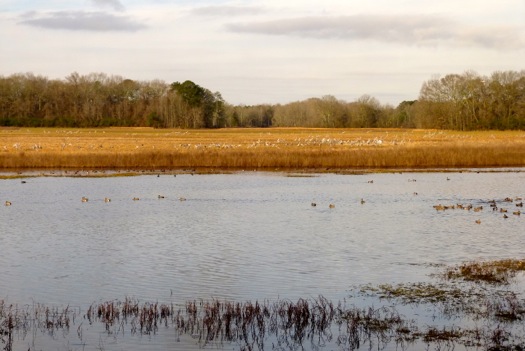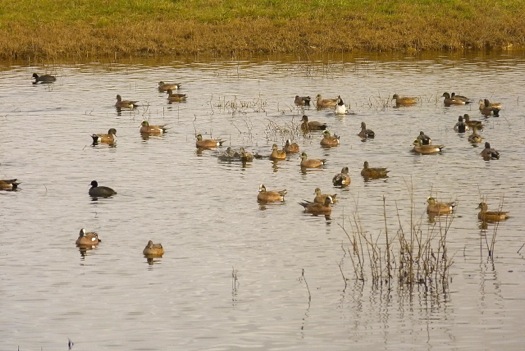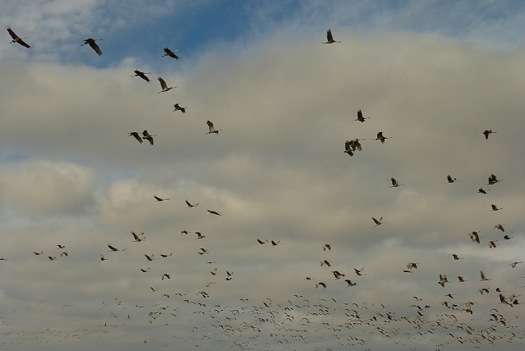After wandering around my garden, a visitor once turned to me and exclaimed, "The birds are so happy!"
That made me very happy, too. I get great joy watching the many birds, squirrels, rabbits, and even occasional foxes who visit my garden. I love lizards, butterflies, dragonflies, ladybugs, and bees. I feel good that so many creatures choose to live in my garden. A healthy garden is one that is full of life. A few of the creatures that call my garden home, clockwise from top left: A green Anole lizard; Bumblebee, Chipmunk (Ground squirrel); Barred owl.
A few of the creatures that call my garden home, clockwise from top left: A green Anole lizard; Bumblebee, Chipmunk (Ground squirrel); Barred owl.
If we create an environment that is good for wildlife, often that garden will be a place that is pleasing to us as well. There are a number of things a gardener can do to make a habitat that is friendly to wildlife.
If you are serious about attracting wildlife to your garden, be sure to use only organic products, rather than artificial fertilizers, pesticides, and insecticides that can harm wildlife. I cringe at those products that have a nuke-em approach, promising to get rid of every bug. Many insects are good guys who eat other bugs that damage our gardens, and insects are an important food source for many birds and other forms of wildlife. This Eastern Bluebird is enjoying a tasty meal.
This Eastern Bluebird is enjoying a tasty meal.
Also, plant a variety of both evergreen and deciduous plants in your garden. This is the best way to insure that your garden will become a wildlife habitat. A diversity of plantings will provide shelter throughout the year, as well as places for birds to nest and raise their young.
A diversity of plantings will provide shelter throughout the year, as well as places for birds to nest and raise their young.  Cardinals have nested in this forsythia bush every year since we moved here in 1985.Trees and shrubs that produce berries - for example: hollies, dogwood, viburnum, hawthorn, and serviceberries - as well as flowering plants that are allowed to go to seed, will provide sustenance.
Cardinals have nested in this forsythia bush every year since we moved here in 1985.Trees and shrubs that produce berries - for example: hollies, dogwood, viburnum, hawthorn, and serviceberries - as well as flowering plants that are allowed to go to seed, will provide sustenance. A robin eats dogwood berries in winter.
A robin eats dogwood berries in winter. Clockwise from top left are some of the berry-producing plants in my own garden: Burford holly; Mapleleaf viburnum; Weeping yaupon holly; Serviceberry tree
Clockwise from top left are some of the berry-producing plants in my own garden: Burford holly; Mapleleaf viburnum; Weeping yaupon holly; Serviceberry tree Rose hips and Coneflower seeds are only a couple of the many types of seed heads that birds and other wildlife consume through the winter.
Rose hips and Coneflower seeds are only a couple of the many types of seed heads that birds and other wildlife consume through the winter.
Many of us enjoy watching the aerial acrobatics of hummingbirds.  Yes, hummingbirds do perch!If you want to attract these amazing creatures, plant brightly colored, nectar-rich flowers that have funnel-shaped blooms as well as those that have distinct “landing zones”. Trumpet creeper, Campsis radicans; Trumpet honeysuckle, Lonicera sempervirens; Bee Balm, Monarda didyma; Indian Pink, Spigelia marilandica; and Red buckeye, Aesculus pavia, are some of our native plants that attract hummingbirds. Rose of Sharon, Hibiscus syriacus; Pineapple sage, Salvia elegans; Shrub verbena, Lantana camera; Giant blue sage, Salvia guaranitca; and Butterfly bush, Buddleja davidii are a few of the non-natives that attract hummingbirds. Spearleaf swampmallow, Pavonia hastata, which is in the hibiscus family, is a favorite in my own garden. Often hummingbirds will ignore the nearby hummingbird feeder and fight over this!
Yes, hummingbirds do perch!If you want to attract these amazing creatures, plant brightly colored, nectar-rich flowers that have funnel-shaped blooms as well as those that have distinct “landing zones”. Trumpet creeper, Campsis radicans; Trumpet honeysuckle, Lonicera sempervirens; Bee Balm, Monarda didyma; Indian Pink, Spigelia marilandica; and Red buckeye, Aesculus pavia, are some of our native plants that attract hummingbirds. Rose of Sharon, Hibiscus syriacus; Pineapple sage, Salvia elegans; Shrub verbena, Lantana camera; Giant blue sage, Salvia guaranitca; and Butterfly bush, Buddleja davidii are a few of the non-natives that attract hummingbirds. Spearleaf swampmallow, Pavonia hastata, which is in the hibiscus family, is a favorite in my own garden. Often hummingbirds will ignore the nearby hummingbird feeder and fight over this! In my own garden, hummingbirds prefer Trumpet honeysuckle and Pavonia hastata.
In my own garden, hummingbirds prefer Trumpet honeysuckle and Pavonia hastata.
Butterflies are also welcome inhabitants of our gardens. They are attracted to colorful perennials and annuals such as Zinnia: Pentas:
Pentas: Cosmos:
Cosmos: Below, clockwise from top left, are more butterfly magnets: Coneflower, Echinacea; Blue mist shrub, Caryopteris; Butterfly weed, Asclepsias; and of course, Butterfly bush, Buddleja.
Below, clockwise from top left, are more butterfly magnets: Coneflower, Echinacea; Blue mist shrub, Caryopteris; Butterfly weed, Asclepsias; and of course, Butterfly bush, Buddleja.
 Butterflies are also drawn to asters, salvia, and to many flowering shrubs, such as azaleas.
Butterflies are also drawn to asters, salvia, and to many flowering shrubs, such as azaleas.
Remember that a water source is important to wildlife, even through the winter. I dream of a pond or a stream, but for now I maintain a couple of birdbaths. I managed to get a rear view of this mockingbird enjoying a birdbath.Many natural wildlife habitats are perishing as modern society expands. We gardeners should do more than just make our yards pretty for ourselves. We can help preserve the local ecology by providing safe and healthy environments for garden creatures. Ultimately, we are benefitting our own lives, as well.
I managed to get a rear view of this mockingbird enjoying a birdbath.Many natural wildlife habitats are perishing as modern society expands. We gardeners should do more than just make our yards pretty for ourselves. We can help preserve the local ecology by providing safe and healthy environments for garden creatures. Ultimately, we are benefitting our own lives, as well.
"Are not two sparrows sold for a penny? Yet not one of them will fall to the ground outside your Father's care." Matthew 10:29
 Saturday, January 16, 2016 at 9:00PM
Saturday, January 16, 2016 at 9:00PM  This morning I was at Wheeler National Wildlife Refuge, near Decatur, Alabama, at the peak of winter migration of the Sandhill Cranes, who began their journey in Wisconsin and southern Canada.
This morning I was at Wheeler National Wildlife Refuge, near Decatur, Alabama, at the peak of winter migration of the Sandhill Cranes, who began their journey in Wisconsin and southern Canada.


 There were literally thousands of Sandhill Cranes, along with even more thousands of different types of ducks.
There were literally thousands of Sandhill Cranes, along with even more thousands of different types of ducks.
 The Whooping Crane is an endangered species, whose numbers at one time dropped to a perilous twenty-one. Careful management has increased their numbers to about 440 in the wild and 160 in captivity, still a very rare bird. There are actually five Whooping Cranes at the refuge, but number five was in another part of the refuge, which covers 35,000 acres.
The Whooping Crane is an endangered species, whose numbers at one time dropped to a perilous twenty-one. Careful management has increased their numbers to about 440 in the wild and 160 in captivity, still a very rare bird. There are actually five Whooping Cranes at the refuge, but number five was in another part of the refuge, which covers 35,000 acres.
 A trio of flying Sandhill Cranes.
A trio of flying Sandhill Cranes.

 White Pelicans fly over in formation.
White Pelicans fly over in formation.







